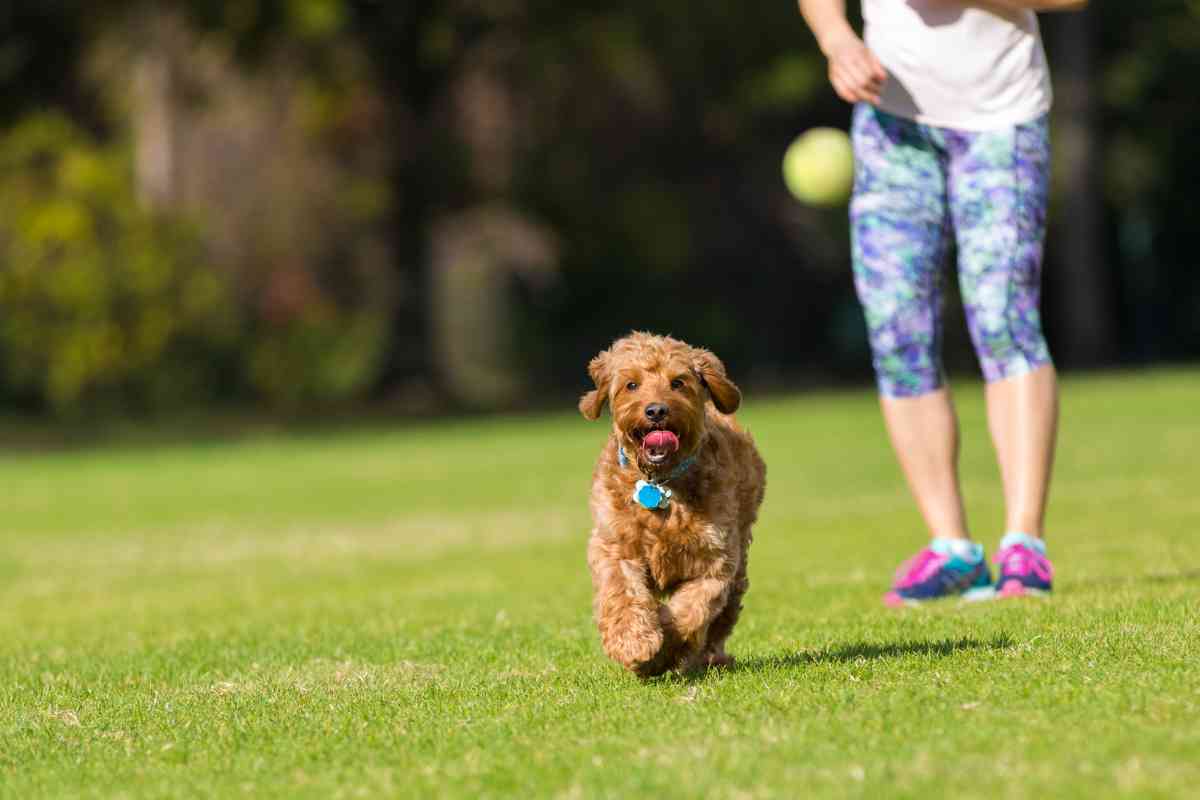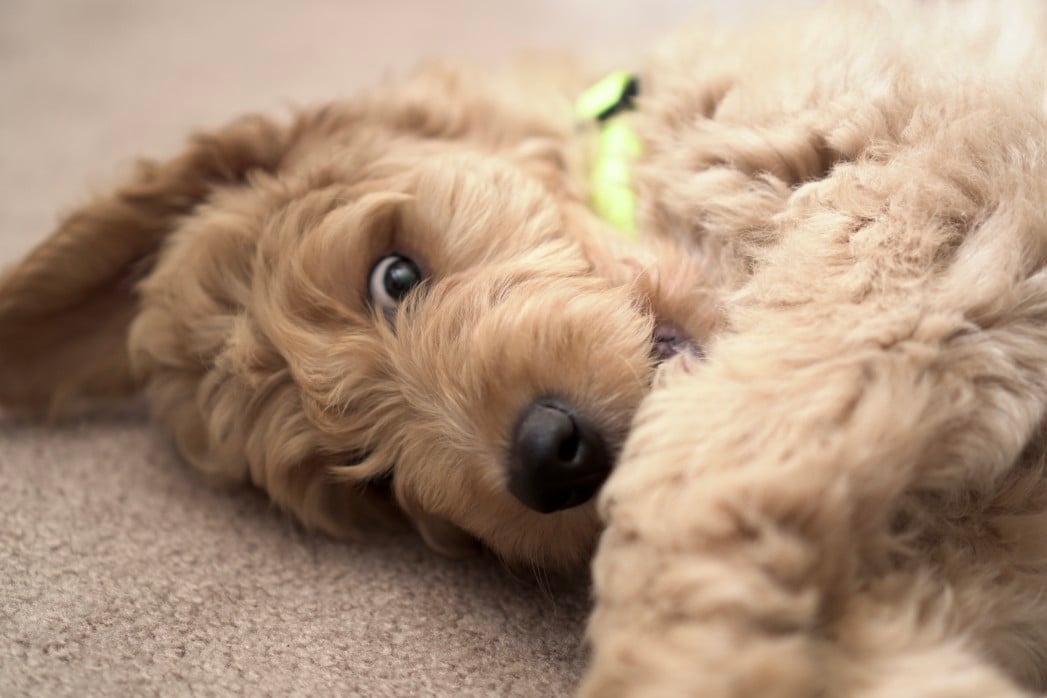Goldendoodle Ear Infection: 3 Common Problems & Treatments (Veterinarian Weighs In!)

Ear infections are one of the most common problems that are seen in dogs. This is very commonly seen in certain breeds, such as Cocker Spaniels and Basset Hounds. There are many different reasons that your Goldendoodle can get an ear infection.
Most of these reasons respond very well to treatment. Fortunately, most ear infections are usually not very serious and can usually be treated with readily available medications.
Reasons Your Goldendoodle Has an Ear Infection
Ear infections commonly occur in Goldendoodles when sebum, wax, hair, moisture, and debris build up in your Goldendoodle’s ear canal. This provides the perfect feeding ground for yeast and bacteria. Common reasons for Goldendoodle ear infections include:
- Allergies
- Bacteria or Fungus
- Ear Mites
The Anatomy of Your Goldendoodle’s Ear
The floppy visible part of your Goldendoodle’s ear is called the pinna. This is that part that you think about when someone says ear.
The inside of your Goldendoodle’s ear that you can see from the outside is called the external ear canal.
The external ear canal consists of two parts. The vertical canal that goes straight down and then takes a 90-degree turn becomes the horizontal canal.
At the end of the horizontal canal is a thin piece of tissue known as the eardrum or tympanic membrane. The eardrum separates the external canal from your Goldendoodle’s middle and inner ear.
Most ear infections will often start in the external ear canal. This includes both the vertical and the horizontal canal. The lining of these canals produces oils and wax.
These waxy products will easily trap bacteria and yeast. Once trapped, they can easily reproduce, causing a serious ear infection in no time.

Symptoms of an Ear Infection in Goldendoodles
If your Goldendoodle has an ear infection, they will tend to show specific signs.
One of the most obvious signs that you can see is a bad smell on your Goldendoodle and black waxy material in your Goldendoodle’s ears.
If you see or smell anything wrong with your Goldendoodle’s ear, it would be best to do more investigating into your ear.
These are other signs you may notice indicating that your Goldendoodle may have an ear infection.
| Signs Your Goldendoodle May Have An Ear Infection |
|---|
| Shaking head very often |
| Scratching at their ears |
| Bad odor from their ears |
| Excess debris in ears or discharge coming from ears |
| Red, irritated ears that can sometimes be painful |
| Scabs or hair loss around ears, usually from scratching |
| Head tilt, especially if their eardrum is ruptured |
If you notice any of these signs in your Goldendoodle, it would be best to make an appointment with your vet especially if the ear looks very inflamed, swollen or has a very bad smell. These are often signs of a very serious ear infection.
Causes of Ear Infections in Goldendoodles
Allergies
Most Goldendoodles are allergic to things in their environment, such as pollen, mold, or chemicals. These can all cause an allergic reaction in your Goldendoodle, leading to an ear infection.
Your Goldendoodle can also have a food allergy. If your Goldendoodle is allergic to something in the food that they are eating, it commonly shows up as an ear infection, the inflamed area around their rectum, or gastrointestinal issues.
This is a common Goldendoodle health issue that may need immediate treatment.
Environmental allergen
Pollen
Pollen is one of the most common allergens for your Goldendoodle to be allergic to. Pollen is found in just about every area of the world, making it very easy for your dog to develop allergies to this.
Both trees and flowers shed pollen into the air, making it very difficult to figure out what pollens that are causing your Goldendoodle to have allergies.
Your vet can run tests to see what your Goldendoodle is allergic to, but these tests can be very expensive, and they are not guaranteed to find a specific allergen.
If they pinpoint a specific allergen, removing all that type of tree from their environment is very hard.
Most people tend to deal with the symptoms of allergies as they arise. Just like with people, there seems to be a time of year when these allergies are worse.
During certain times of the year, your Goldendoodle with seasonal allergies will show little to no signs of allergies at all.
Mold
Mold is another common allergy to Goldendoodles. Your Goldendoodle can be allergic to many different types and species of mold.
Each type of mold is formed from a fungus. Each type of fungus grows into a specific form, which is how your vet knows how to identify them. All fungi need a dark and damp place to thrive.
These are commonly found under a porch or behind furniture, which is also places where our pets also seem to like to sleep.
Deep cleaning your house can certainly help, but these cleaners may also be adding to the problem.
Chemicals
Some Goldendoodles are showing more and more signs that they are allergic to human-made soaps and dyes.
If you have noticed that every time you wash your Goldendoodle’s bedding or toys, they seem to itch a little more, or even have little raised bumps on their skin they may be allergic to the detergent that you are using.
The chemicals found in some detergents can be very irritating to your Goldendoodle. An allergic reaction such as a rash or an ear infection is a good sign that your Goldendoodle is allergic to something that they have come into direct contact with.
Most allergic reactions are very mild and can easily be treated at home with antihistamines such as Benadryl or frequent ear cleanings.
Some allergic reactions can cause a more severe reaction like a swollen face or leg. Your Goldendoodle can even have trouble breathing.
If you notice any of these more severe signs, your Goldendoodle would require immediate veterinary care. Some allergies will not easily clear up on their own.
Some of these may become much more severe and can cause a secondary infection that can be even more difficult to treat.
Dog Food Allergies
Many pet foods are having artificial coloring and food dyes. These dyes are put into your Goldendoodle’s food to make food look more presentable.
These dyes offer no real nutritional value, and can occasionally make your pet have an allergic reaction.

Food dyes are not a natural substance that your Goldendoodle’s intestines are used to, so your Goldendoodle can have a reaction to these dyes.
Common things that your Goldendoodle may be allergic to in its food:
- Artificial ingredients
- Food dyes
- Fillers
- Meat by Products
- Beef
- Dairy
- Wheat
- Eggs
- Chicken
- Lamb
- Soy
The most common signs of food allergies are rash around the rectum and ear infection.
If you do think that your Goldendoodle’s ear infection is from a food allergy, talk to your vet about food allergy testing or food trial.
Bacterial or Fungus
Most ear infections are due to bacteria or fungus overgrowing in your Goldendoodle’s ears. Goldendoodle’s ears are floppy and sometimes have a lot of hair growing in them. This makes the perfect environment for your Goldendoodle to develop an ear infection.
When excess bacteria or yeast grows in your Goldendoodle’s ear canal, the external ear canal will become inflamed. This causes a condition called otitis externa.
- A Goldendoodle with their floppy ears may be more prone to ear infections than dogs whose ears stand straight up. Some dog breeds, such as Basset Hounds and Cocker Spaniels, are very susceptible to ear infections.
- Some dogs may even secrete more earwax and sebum than other dogs. Some Goldendoodles have too much hair inside the ears. All of these conditions will make the ears much more likely to develop an ear infection.
- If your Goldendoodle likes to swim, they may have a lot of excess moisture in the Goldendoodle’s ears. This can lead to bacterial or yeast overgrowth in their ears.
Many times, a bacteria or yeast infection will cause a very bad odor coming from your dog’s ear along with black waxy debris.
If you notice this in your dog’s ears, it would be best to see your vet. They can examine your dog’s ears and get them started on the correct medication to treat these infections.
Ear Mites
Ear mites can also lead to an ear infection. If your Goldendoodle has ear mites, these mites can cause irritation to your Goldendoodle’s inner ear, leading to an infection.
Usually, ear mites are only seen in young puppies or kittens that were rescued off the streets or in a shelter. Usually, these are easily treated when they are young and are not really seen in adult Goldendoodles.
If you think your Goldendoodle has ear mites, it would be best to take it to the vet. Your vet will take a sample from your Goldendoodle’s ears and look for mites under the microscope.
These mites can easily be seen under a microscope. If your Goldendoodle has ear mites, your vet can prescribe medication to clear the mites infestation.
It is almost impossible to distinguish an ear infection from ear mites without the help of a microscope.
Diagnosis of an Ear Infection in Your Goldendoodle

As soon as you notice an ear infection in your Goldendoodle, you should take your dog to your vet. This will help prevent the ear infection from getting any worse or causing any other problems in your Goldendoodle’s ear.
Typically, your vet or vet tech will use a cotton tip swab to get a sample of the debris and discharge in your Goldendoodle’s ear. The sample will be smeared on a microscope slide and stained using a special stain.
When your vet looks under the microscope, they can determine if there is yeast or bacteria present in your Goldendoodle’s ear. This process is typically called ear cytology, and it is a very important diagnostic
tool . This will help your vet develop a treatment plan for your Goldendoodle.
If your vet finds the presence of yeast, bacteria, or both, this would confirm an ear infection diagnosis. A Goldendoodle with a yeast-related ear infection will often have dark brown or black debris in the ears.
A Goldendoodle with a bacterial ear infection may have yellow-brown debris or even pus coming from their ears.
Without microscopic evidence of bacteria or yeast, your vet cannot be certain of the type of ear infection that is present in your Goldendoodle.
They also will not know what they need to do to treat this infection without knowing what is in your Goldendoodle’s ear.
If your Goldendoodle has a severe infection, your vet may want to take a culture of the substance in your dog’s ears. This will tell your vet exactly which antibiotics will kill the infection.
Some ear infections are resistant to certain antibiotics, and your Goldendoodle will need a special antibiotic to treat this infection.
A culture will help your Goldendoodle’s ear infection clear up even fast since your vet will be able to use the correct antibiotic for their infection.
Treating Ear Infections in Your Goldendoodle
Once an ear infection in your Goldendoodle has been diagnosed, your vet can discuss the proper treatment and different ways to prevent these from happening again.
In many cases, your vet will clean your Goldendoodle’s ears. If there is excessive ear hair, your vet or groomer may need to pluck this hair.
Sometimes, it can be very painful, and your vet may want to leave this hair until after the infection is gone.
Removal of all of the excess debris, waxy discharge, and hair is a very important step to be able to start the healing process and allow the ear medications to work.
Your vet may prescribe a liquid ear medication that you will need put directly into your Goldendoodle’s ears a few times a day. There are also medications that your vet can put in your Goldendoodle’s ears only once a week. Discuss each of these different options with your vet.
Many vets have started using them once-a-week medication so that owners do not have to struggle with their Goldendoodle every day, putting medication in their ears. Most people often forget a few times, causing these ear infections to take even longer to heal.
At-home ear medication will typically need to be applied to the ear one to three times daily.
Your vet may also send you home with an ear cleaner or an ear flush solution. They will show you how to clean your Goldendoodle’s ears regularly.
Your vet may also send you home one or more oral medications.
This would be antibiotics or anti-inflammatories that would help treat the infection and help decrease any swelling or inflammation; what medication your vet sends home all depends on the severity of the infection.
Your vet will decide what is the best treatment for you and your Goldendoodle and help your dog’s ears return to normal.
It is very important that you comply with your vet’s recommendations on how to manage an ear infection in your Goldendoodle. Otherwise, serious and potentially irreversible complications may occur.
Do not stop any ear treatment early, even if you think that the ear infection is gone.
If you do not think your dog is getting better or that the ear treatment does not seem to be clearing up your Goldendoodle’s ear infection, contact your vet for advice.
Do not try to attempt to treat your Goldendoodle’s ear infection using home remedies without your vet’s advice.
These can cause even more damage to your Goldendoodle’s ear. If the eardrum is ruptured, it can make it very dangerous to put anything into the ear.
Just as essential as you follow through with all of your vet’s recommended treatments, it is also extremely important that you take your Goldendoodle back to the vet for rechecks if your vet recommends it. And make sure to let your vet know if your Goldendoodle’s ears are not improving.
Goldendoodles who have a chronic ear infection will require lifelong maintenance. There is no cure for a chronic ear infection and it will likely be with your Goldendoodle until they pass away.
Instead, it is about keeping your Goldendoodle’s ears clean, keeping their allergens to a minimum and preventing any infection from getting out of control.
Some Goldendoodles will need to see their vet every few months, and some even more frequently to help manage their chronic ear infections.
Complications of Chronic or Untreated Ear Infections
If an ear infection in your Goldendoodle goes untreated, it can cause further damage to the ear.
Sometimes serious complications may occur if your Goldendoodle’s ear infection spreads beyond the external ear canal and into their inner or middle ear.
This can cause hearing loss, facial nerve paralysis, vestibular dysfunction, ocular issues, or other permanent problems that may occur.
If your Goldendoodle has a chronic ear infection, the skin around the ear canal may be very thickened and scarred.
They will cause the canal itself to become closed or stenotic. This will make treating your Goldendoodle’s ear infection even more difficult.
In the very worst cases of ear infections, your veterinarian may recommend surgery to remove the ear canal and close the ear permanently. This is a procedure called a total ear canal ablation and bulla osteotomy, also known as TECA-BO.
Other Problems That Ear Infections Can Cause
Ear infections can cause hematomas in your Goldendoodle’s ears. Ear infections tend to make your dog itch their ears and shake their head often.
When your Goldendoodle is itching and scratching their ear’s, they can easily rupture the blood vessels that are in the ears.
When this happens, blood will fill up between the two cartilage pieces in your Goldendoodle’s ears. This makes the ear look like a big pillow.
Many times, you will have to take your Goldendoodle to the vet if you notice this. Your vet will drain the pocket and give your dog some medication to reduce the swelling.
Sometimes this continues to fill right back up, and your vet will have to do surgery to open this pocket and suture the two pieces of cartilage back together.
Preventing Ear Infections in Your Goldendoodle
If your Goldendoodle has recurring ear infections, setting up a weekly ear cleaning schedule is best. This will help prevent any infection in your Goldendoodle’s ears.
If your Goldendoodle’s ear infections are because of allergies, you can easily manage these with antihistamines such as Benadryl or prescription allergy medication.
Your vet may even recommend a good medicated ear cleaner for you to use or other preventative maintenance for your Goldendoodle’s ears.
How To Clean Your Goldendoodle’s Ears
You can easily learn to clean your Goldendoodle’s ears at home to help prevent any infection from setting in.
These are the steps you can follow in cleaning your dog’s ears:
At first, you may want help when cleaning your Goldendoodle’s ears, but eventually, this can be a one-person job. Many Goldendoodles even learn to enjoy having their ears cleaned.
- Get Ear Cleaner from the pet store or your vet. This ear cleaner contains an antifungal and antibacterial ingredient to help prevent your Goldendoodle from developing an ear infection.
- Look for hair growing in your Goldendoodle’s ears. If you notice a lot of hair coming from your Goldendoodle’s ear canal, you can easily remove this by pulling the hair with your fingers or a hemostat. By removing this hair, you are helping your Goldendoodle’s ears stay free of bacteria. Most bacteria and yeast can easily attach to this hair, making a great environment for growing.
- Grab a handful of cotton balls. These will be used to gently wipe out any ear cleaner from your dog’s ears.
- Use the cleaner and fill your Goldendoodle’s ear canal. As soon as you put the ear cleaner in your dog’s ear, they will want to shake this out. You will want to hold on to their ear flap to prevent them from shaking everything right out.
- Once the ear canal is full, place a few cotton balls at the opening of your Goldendoodle’s ear.
- Gently massage the base of the ear. This is helping break up any waxy and debris that is in your Goldendoodle’s ear.
- Gently use the cotton ball to wipe away any excessive ear cleaning from your Goldendoodle’s ear.
- Continue this process a few times until there is no more brown waxy debris on the cotton balls.
- Use Q-tips to clean the folds on the external ear. Do not use Q tips deep in your dog’s ear as you can easily damage the eardrum. If you cannot see the end of the Q tip, then you have gone too far.
- After your Goldendoodle’s ears are clean, you can let them flop their ears. This will help get any extra cleaner out of their ears.
This can easily be done each week to help prevent ear infections in your Goldendoodle. Do not get discouraged; even the strictest cleaner’s Goldendoodle will eventually have an ear infection.
But by trying to do your best to keep them as clean as possible, these infections will be very mild, and you should not have any other complications.
Other things that you can do to keep your Goldendoodle’s ears clean
You can do other things to try to prevent ear infections in your Goldendoodle. By having a good prevention plan, you may be able to keep your Goldendoodle from ever developing an ear infection.
Ear Wipes: You can use ear wipes to keep your Goldendoodle’s ears clean. These wipes look just like baby wipes and can be used to wipe out your Goldendoodle’s ears every day.
This is a great thing to do, especially after your Goldendoodle comes inside from playing fetch outside.
Keep Hair Short: When your Goldendoodle goes to the groomer, make sure that your groomer removes all the hair out of your Goldendoodle’s ear.
Also, keeping the hair short on the underside of your Goldendoodle’s ears will allow air to get into the ear canal, making it harder for bacteria and yeast to grow.
Examine your Goldendoodle’s ears: It is good to practice looking in your Goldendoodle’s ears every few days. This will help you identify any infection before it gets too bad.
As soon as you start to see an infection set in, bring your Goldendoodle to the vet. They can start treatment before the infection gets out of hand.

Your Thoughts?
Tell us about your Goldendoodle in the comments below. Is your Doodle a water dog? As much as Lexie loves to swim, she hates getting her feet or tush wet outside in the rain! We’d love to hear about your experiences in the comments below! Thanks in advance for sharing!
Final Thoughts
If your Goldendoodle has an ear infection, your vet can help you figure out what is causing these infections and get your Goldendoodle the appropriate treatment.
These infections can be caused by allergies, bacteria, yeast, or ear mites, depending on what is causing the infection will determine what you use to treat the ears. Once your vet has determined the cause of the infection, they can easily treat your Goldendoodle’s ear infection.
Once the infection is gone, you can easily prevent most ear infections with a little preventative care.
Recommended Reading:
- Do Goldendoodles Like Water?
- Goldendoodle Exercise Needs: Veterinarian Guidelines
- How Do I Know if My Goldendoodle is Overweight?
- 11 Things To Know Before Getting A Goldendoodle
- How To Prevent Goldendoodle Matting
- Goldendoodle Ear Infection: 3 Common Problems
- Don’t Take Your Dog Swimming Until You Read This Warning! 🚨
- 5 Fun Ways To Bond With Your Goldendoodle
Related Content You May Find Interesting
Here are some more articles that may be of interest to you about caring for your Goldendoodle!
Summary
This article provides information on ear infections in Goldendoodles, including the causes, symptoms, and treatment. The main points are:
- Ear infections are common in dogs and certain breeds such as Cocker Spaniels and Basset Hounds are prone to them.
- The most common reasons for ear infections in Goldendoodles are allergies, bacteria or fungus, and ear mites.
- The external ear canal is where most ear infections start, as it produces oils and wax that can trap bacteria and yeast.
- Symptoms of an ear infection in Goldendoodles include bad odor, black waxy material, shaking head, scratching ears, redness, and scabs or hair loss around ears.
- Allergies, pollen, mold, and chemicals are common causes of ear infections in Goldendoodles, and deep cleaning the house, avoidingco human-made soaps and dyes, and keeping the ears dry can help prevent them. Treatment usually involves cleaning the ears and administering medication.




